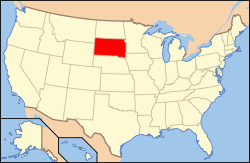Hyde County, South Dakota
| Hyde County, South Dakota | |
|---|---|
 Location in the state of South Dakota | |
 South Dakota's location in the U.S. | |
| Founded | 1883 |
| Seat | Highmore |
| Largest city | Highmore |
| Area | |
| • Total | 866 sq mi (2,243 km2) |
| • Land | 861 sq mi (2,230 km2) |
| • Water | 5.6 sq mi (15 km2), 0.6% |
| Population | |
| • (2010) | 1,420 |
| • Density | 1.7/sq mi (1/km²) |
| Congressional district | At-large |
| Time zone | Central: UTC-6/-5 |
Hyde County is a county located in the U.S. state of South Dakota. As of the 2010 census, the population was 1,420,[1] making it the fourth-least populous county in South Dakota. Its county seat is Highmore.[2] The county was founded in 1873, as a county of the Dakota Territory, and organized in 1883.[3] It was named for James Hyde, a member of legislature in the 1870s.[4]
Geography
According to the U.S. Census Bureau, the county has a total area of 866 square miles (2,240 km2), of which 861 square miles (2,230 km2) is land and 5.6 square miles (15 km2) (0.6%) is water.[5]
Major highways
 U.S. Highway 14
U.S. Highway 14 South Dakota Highway 26
South Dakota Highway 26 South Dakota Highway 34
South Dakota Highway 34 South Dakota Highway 47
South Dakota Highway 47
Adjacent counties
- Faulk County, South Dakota - north
- Hand County, South Dakota - east
- Buffalo County, South Dakota - south
- Lyman County, South Dakota - southwest
- Hughes County, South Dakota - southwest
- Sully County, South Dakota - west
- Potter County, South Dakota - northwest
Demographics
| Historical population | |||
|---|---|---|---|
| Census | Pop. | %± | |
| 1890 | 1,860 | — | |
| 1900 | 1,492 | −19.8% | |
| 1910 | 3,307 | 121.6% | |
| 1920 | 3,315 | 0.2% | |
| 1930 | 3,690 | 11.3% | |
| 1940 | 3,113 | −15.6% | |
| 1950 | 2,811 | −9.7% | |
| 1960 | 2,602 | −7.4% | |
| 1970 | 2,515 | −3.3% | |
| 1980 | 2,069 | −17.7% | |
| 1990 | 1,696 | −18.0% | |
| 2000 | 1,671 | −1.5% | |
| 2010 | 1,420 | −15.0% | |
| Est. 2014 | 1,396 | −1.7% | |
As of the census[10] of 2000, there were 1,671 people, 679 households, and 456 families residing in the county. The population density was 2 people per square mile (1/km²). There were 769 housing units at an average density of 1 per square mile (0/km²). The racial makeup of the county was 91.08% White, 0.12% Black or African American, 7.96% Native American, 0.12% Pacific Islander, 0.12% from other races, and 0.60% from two or more races. 0.48% of the population were Hispanic or Latino of any race.
There were 679 households out of which 29.60% had children under the age of 18 living with them, 55.70% were married couples living together, 6.00% had a female householder with no husband present, and 32.80% were non-families. 30.30% of all households were made up of individuals and 17.10% had someone living alone who was 65 years of age or older. The average household size was 2.41 and the average family size was 3.00.
In the county, the population was spread out with 25.60% under the age of 18, 5.80% from 18 to 24, 23.50% from 25 to 44, 22.70% from 45 to 64, and 22.30% who were 65 years of age or older. The median age was 42 years. For every 100 females there were 102.10 males. For every 100 females age 18 and over, there were 97.00 males.
The median income for a household in the county was $31,103, and the median income for a family was $40,700. Males had a median income of $24,728 versus $18,833 for females. The per capita income for the county was $16,356. About 7.80% of families and 12.30% of the population were below the poverty line, including 13.40% of those under age 18 and 13.70% of those age 65 or over.
Communities
City
- Highmore (county seat)
Towns
Townships
The county is divided into many townships:
- Banner
- Bramhall
- Douglas
- Eden
- Franklin
- Holabird
- Highmore
- Illinois
- Lincoln
- Loomis
- Spring Lake
- Union
- Valley
- William Hamilton
Unorganized territories
The county contains three areas of unorganized territory: Central Hyde, Crow Creek, and North Hyde.
See also
References
- ↑ 1.0 1.1 "State & County QuickFacts". United States Census Bureau. Retrieved November 25, 2013.
- ↑ "Find a County". National Association of Counties. Retrieved 2011-06-07.
- ↑ "Dakota Territory, South Dakota, and North Dakota: Individual County Chronologies". Dakota Territory Atlas of Historical County Boundaries. The Newberry Library. 2006. Retrieved March 29, 2015.
- ↑ Gannett, Henry (1905). The Origin of Certain Place Names in the United States. Govt. Print. Off. p. 164.
- ↑ "2010 Census Gazetteer Files". United States Census Bureau. August 22, 2012. Retrieved March 26, 2015.
- ↑ "U.S. Decennial Census". United States Census Bureau. Retrieved March 26, 2015.
- ↑ "Historical Census Browser". University of Virginia Library. Retrieved March 26, 2015.
- ↑ Forstall, Richard L., ed. (March 27, 1995). "Population of Counties by Decennial Census: 1900 to 1990". United States Census Bureau. Retrieved March 26, 2015.
- ↑ "Census 2000 PHC-T-4. Ranking Tables for Counties: 1990 and 2000" (PDF). United States Census Bureau. April 2, 2001. Retrieved March 26, 2015.
- ↑ "American FactFinder". United States Census Bureau. Retrieved 2011-05-14.
 |
Potter County | Faulk County |  | |
| Sully County | |
Hand County | ||
| ||||
| | ||||
| Hughes County and Lyman County | Buffalo County |
| |||||||||||||||||||||||||